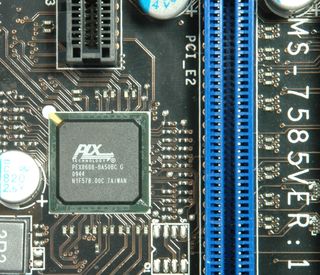USB 3.0, SATA 6Gb/s, Motherboards, And Overcoming Bottlenecks
Soon, 4.8 Gb/s USB 3.0 and 6 Gb/s SATA will be hitting the mainstream. But be careful when you buy your next mainstream motherboard; some don't handle these technologies very well. We compare three implementations and recommend best practice solutions.
Bottlenecks And Solutions For USB 3.0 And SATA 6Gb/s
All AMD 700 and 800 chipsets (both northbridge and southbridge) fully support PCI Express 2.0, while Intel’s PCIe 2.0 support is limited to the northbridge/processor-based interface (the company continues claiming PCIe 2.0 support on platforms like P55, despite the 2.5 Gb/s limitation). This is why it's unlikely you'll encounter bandwidth bottlenecks on AMD platforms.
But let's say you're looking for a new P55-based motherboard, though. There are still a few options to pursue. Intel controllers typically utilize a single PCI Express lane for the sake of simplicity. Of course, performance bottlenecks could be solved by connecting to the host system using two or four lanes, but that's not the solution you'd want to rely on, since most consumer motherboards only offer x1 and x16 slots.
The first solution is simply to use existing PCIe 1.1 lanes to attach USB 3.0 and SATA 3.0 controllers. This yields a maximum bandwidth of 250 MB/s. Obviously, this approach should be avoided because it handicaps third-generation SATA below the performance levels of even SATA 3Gb/s. It also bottleneck's USB 3.0, too. For individual USB 3.0 drives, this might not be painfully apparent, but as soon as you operate two drives in parallel (or once SSDs exceed 300 MB/s throughput), this bottleneck will start to hurt a lot more.
If you want to see this challenge overcome properly, check out Asus' P7P55D Premium motherboard, which employs a PLX 8613 chip to condense the bandwidth of multiple PCIe 1.1 lanes into a PCIe 2.0 link. Latency-wise, this is not perfect, but it's still better than multiple PCIe 1.1. links. Unfortunately, it's also expensive, resulting in a board that costs more than many mainstream customers are willing to pay. At under $200, the P7P55D-E Pro is perhaps a more attractive mainstream offering that "does switching right."
The second approach to overcoming bandwidth limits is to link high-speed components, such as USB 3.0 or SATA 6Gb/s controllers, to the primary PCI Express 2.0 lanes. This will result in the 16 main graphics lanes sharing bandwidth with high-speed storage interfaces. Gigabyte’s P55A-UD6 uses this solution. Unfortunately, if you actually use the USB and SATA controllers, this knocks your graphics card down to x8 mode. Worse, if you run in CrossFire mode (employing two x8 links), the USB and SATA controller get knocked back to 2.5 Gb/s links. Either way, you're sacrificing performance in order to add support for the latest standards.
Finally, you can allocate available bandwidth in a more flexible way. This is done on Gigabyte’s P55A-UD7 motherboard, which works around the -UD6's limitations. The -UD7 includes an nForce 200 bridge, capable of multiplexing the processor's PCI Express connectivity to support a broader array of graphics configurations (not to mention adding SLI support). A PLX PEX 8608 switch is needed to enable the next-gen SATA and USB controllers found on-board, too.

MSI and Gigabyte use the PLX 8608 PCI Express switch to allow dynamic bandwidth switching between available 16 PCI Express 2.0 lanes, multiple x16 slots, and high-speed devices, including USB 3.0 and SATA 6Gb/s controllers.
Stay on the Cutting Edge
Join the experts who read Tom's Hardware for the inside track on enthusiast PC tech news — and have for over 25 years. We'll send breaking news and in-depth reviews of CPUs, GPUs, AI, maker hardware and more straight to your inbox.
Current page: Bottlenecks And Solutions For USB 3.0 And SATA 6Gb/s
Prev Page Why PCI Express 2.0 Matters Next Page Gigabyte P55A-UD6 (Graphics Versus Connectivity)Most Popular

